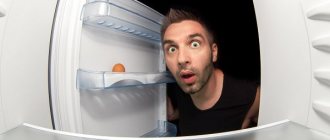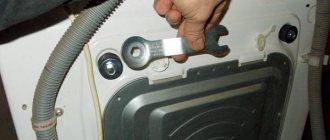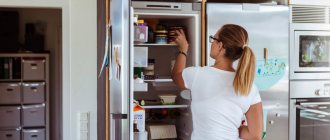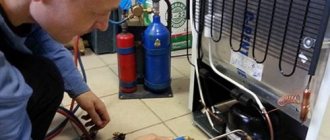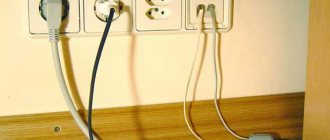Published: 25 Jan 2022
Most often, users encounter this situation when they find frozen food in the refrigerator compartment and/or ice on the back wall. Models with a display can show negative temperatures in the refrigerator compartment.
The freezer compartment freezes less often. Users recognize this by the temperature on the refrigerator display being too low and/or ice in the freezer.
Sometimes both compartments of the refrigerator get very cold at the same time.
Let's summarize what you can notice when the refrigerator freezes food:
- the temperature in one or both chambers is below normal;
- Ice has formed in the refrigerator and/or freezer compartment;
- the compressor runs almost non-stop;
- Refrigerator models with No-Frost may make cracking noises and other noises.
If you notice one or more of the “symptoms” from the list, the technician clearly needs help.
The connection between refrigerator breakdowns and the principle of its operation
Refrigerator elements:
- compressor (motor). In the vast majority of cases - one, less often - two in advanced and expensive models;
- outlet circuits according to the number of chambers. Usually two, for the refrigerator and freezer compartments, which allows you to set the temperature there separately;
- defrost system: evaporator and heat exchanger (condenser). The NoFrost system is equipped with a small fan (impeller), heating element;
- air ducts, dampers. For drip (“crying”) defrosting, a flow-distributing solenoid valve;
- a system of tubes (capillary, etc.) for refrigerant circulation;
- power circuit, control and electrical parts, including microcircuits: temperature sensors, relays, thermostat;
- cabinet with doors on hinges, with a seal around the perimeter.
The equilibrium in the refrigerator system is dynamic: if there is excessive energy consumption in one of the compartments, then there may not be enough energy in the other. Most often, this is why the refrigerator does not freeze well. A violation can be caused by setting values for two compartments with independent settings at the same time to the maximum. Even a reliable compressor may not meet the needs of such a regime. You have to choose one of two: super freezing or super cooling. Such incorrect operation is excluded for two-compressor units.
Defrosting
Although the breakdowns are essentially the same, there are slight differences in the elements, for example, the NoFrost fan and heating element may break, but the drip version does not have them (there is often a static defrosting circuit).
System options:
- drip (“crying” defrosting). When the compressor pauses, the coat of ice and frost melts on the walls and evaporator, and water flows down the grooves to the pan. Cold flows are distributed via a solenoid valve;
- NoFrost. There is a defrost system. The fan creates air circulation, preventing the formation of frost. If it appears, the impeller is turned off and the heating element (heater) is activated. Thawing occurs and water collects on the tray. This system also has motorized air dampers.
If there is no drip defrosting, but NoFrost, then the energy and air are directed to the negative compartment with an evaporator - a “defrost” with a heating element, which looks like a radiator or a coil with partitions. Separately, there is a similar element of this system, but with completely different functions (for heat exchange) - a condenser on the back wall of the cabinet. The secondary flow is forced by a fan into the positive chamber. If the control valves break down (sticking, jamming, incorrect operation), the freezer freezes, and an excessively high temperature occurs in the positive compartment.
For units with manual (drip) defrosting, the refrigerant circulates, being divided by a magnetic valve into two evaporators. If this element breaks down, incorrect cooling in the compartments may also occur.
Useful tips
- Adjust to the warmest temperature, if the shift towards frost is small - 2-3 C, then this will help in electronically controlled equipment. But this is rather a temporary measure - if the temperature sensor begins to jam, then it has little time left to work: from 7 to 30 days.
- A temporary resolution can be turning on the equipment through a time relay with subsequent periodic installation: 30 minutes. on and 30 min. off 45 minutes is acceptable. on, 45 off, but remember that the time off should not be less than 15 minutes. In this mode, food will not freeze, and you will be able to call a specialist at a time convenient for you.
An unregulated decrease in temperature in the device is considered a sign of a serious failure in the system. Only prompt repair of the breakdown will save the refrigeration unit from costly repairs.
Common breakdowns and variants of incorrect operation
The most common problems are:
- poor fit of the doors, resulting in a layer of snow appearing in the freezer;
- faulty monitoring and control system: sensors, thermostat, control unit;
- clogged capillary tubes, decreased compression (pressure), refrigerant leak when there is only enough to support the freezer - these are common situations if the unit does not freeze;
- breakdown (overheating) of the motor;
- malfunction of defrost, valves.
Each chamber, refrigeration and freezer, or two at the same time, may experience different levels and modifications of temperature violations, especially if it is not a new refrigerator.
To summarize, problems can be grouped into two types: freezing is observed in one compartment and the other is working weaker, or both compartments are cooling poorly. Options:
- the minus compartment functions well or freezes, but the refrigerator does not;
- there is a certain level of cooling, but not according to the set parameters, or insufficient;
- the positive compartment is working, but not in the right direction - it freezes.
The refrigerator compartment works poorly, the freezer works well
A sign of incorrect operation: in the positive compartment the temperature is excessively high, but in the freezer it corresponds to the norm.
If the freezer has the NoFrost function, the first reason why the refrigerator in the minus compartment gets very cold is a malfunction of the defrost (evaporator), namely the heating element, it does not heat up for defrosting. The system becomes icy. The circulation of air flows that are extremely important for the refrigerator is disrupted.
If the impeller begins to touch the ice on the radiator, moves with difficulty and jams, then the air duct freezes. That is, if the refrigerator is very cold (refrigerator compartment, freezer is freezing), the reason is defrosting. Further, after leaving the plus segment, the cold will begin to disappear from the freezer. A characteristic sign of a breakdown is a noisy fan, squeaks, then silence.
Definition of failure
The option for what to do if the refrigerator gets very cold is the following for the case described. You can try doing a complete manual defrost (it will take about a day). The obstacle to the blades will disappear, but if even after this the impeller does not spin, the services of a specialist will be required. If the system becomes operational, and then the problem occurs again, this means that the defrost malfunction is confirmed - the heating element or evaporator temperature sensor must be changed.
In a drip system, the cause may be due to incorrect operation of the defrost activation timer. For two-compressor models, diagnostics can be carried out in the described way, without turning off all cameras.
Other failure factors:
- The thermostat, controls and adjustments have failed;
- freon leak;
- compressor is broken.
It is also important to check whether the light in the chambers goes out when closing the cabinet: the button may be broken, there is no fit, there is no contact. We need to see if there are any distortions. The situations listed above, as well as refrigerant leaks and compressor breakdowns, are most typical for older refrigerators.
The freezer freezes poorly, the refrigerator compartment freezes
Sometimes a breakdown, when the temperature in the chambers is high and does not display the specified levels, is called the general term “poor freezing.” A type of malfunction is an increase in the values in the minus compartment to the defrosting level, and in the refrigeration part there is overfreezing and ice freezes. The refrigerator does not cool, the minus compartment is very cold.
The reasons if the refrigerator began to freeze heavily in the positive compartment are standard, but with a different mechanism for the malfunction of the elements:
- cyclic on/off The compressor depends on the thermostat. When the latter fails, the motor runs without interruption, and excess cold is pumped in. At the same time, defrosting is not activated in NoFrost, the evaporator freezes over and becomes covered with ice. There is no cold flow into the upper freezer compartment; accordingly, it is increasingly directed to the refrigeration section. If the compressor does not turn on for a long time, then the effect is at first similar - then all chambers begin to cool slightly;
- It is not possible to rule out a breakdown, but rather an incorrect setting of the operating mode by the user.
All cameras are slightly cold
Reasons if the refrigerator does not freeze and the temperature is high in all chambers:
- The main reason for the violation of the temperature regime in all compartments is a gas leak (freon), the pressure drops, the circulation of the refrigerant weakens, and heat removal is difficult. The temperature rises first in the plus segment, then in the freezer;
- similar consequences if the capillary tube becomes clogged;
- incorrect operation of the control unit. Often, it is impossible to set the desired mode or turn it off.
Poor freezing, no cycling, compressor running constantly
The refrigerator, or rather its compressor, must operate with pauses necessary for the set mode. Continuous operation - a sign of malfunction - is determined by the indication or by the constant hum of the motor, vibration of the cabinet.
One of the reasons why the upper chamber of the refrigerator does not freeze is that the volume of refrigerant has become insufficient due to a leak. Mechanism: there is not enough freon to maintain a low temperature, which is detected by the automation and, trying to reach a given level, forces the process by operating the compressor without pauses.
This can also be observed when the refrigerator is in working order, for example, during the period when normal operation is established after defrosting. But if there is a malfunction in the compartments, the temperature does not reach the set values, remains high constantly and the refrigerator begins to freeze poorly in all compartments.
You can verify the nature of the breakdown yourself by inspecting the cooling circuit: defrost it, after cleaning the freezer will stop working altogether.
There is a danger of another breakdown: the compressor is overloaded, so after prolonged operation it also breaks down.
The refrigerator started to get very cold - the food is freezing
It will be a real disaster for users if the refrigerator gets very cold. What to do if the cavity inside is frozen with a fur coat, food touches the ice, loses its taste, and freezes. First of all, you need to find the cause of the disaster.
- check the settings of the refrigerator parameters and modes;
- make sure the door closes tightly;
- clean the drain hole if it is clogged with ice;
- make sure that the thermostat is working properly and responds to commands.
Only a master can check how the electronic control works, reconfigure and debug the mode. In the meantime, you need to move the food away from the walls, move it to the warmest part, closer to the door.
Summary and diagnostic guide
Let's summarize all the cases why the cooling system does not work and their description. The table can be used as a kind of guide, which is enough for preliminary diagnosis of breakdowns.
| Sign of breakdown | Description, reason |
| The freezer is not freezing. All departments work poorly together or separately. |
|
| There is no shutdown, both refrigerator chambers do not work or function poorly. There may be frost on the radiator and condenser. | Capillary tube clogged. If there is a malfunction, the refrigerant can mix with the oil in the engine, forming paraffins and causing a plug. |
| The freezer compartment does not freeze, but the lower (plus, refrigerator) part freezes. | Solenoid valve problems. There are 2 modes for single-compressor models with independent control of the chambers: cooling only the freezer and cooling it together with the refrigerator compartment. The described situation occurs when the valve sticks in the second position. |
| The breaks are rare, but the temperature in the freezer is increased, the plus compartment is functioning normally. | The door does not fit properly, the seal is damaged. The hinges are incorrectly adjusted (misaligned, etc.). |
| The bottom compartment of the refrigerator does not function, but the freezer does. | Broken fan, valves, dampers. Faulty defrost, air ducts are frozen. |
Typical breakdowns of models with NoFrost
Full NouFrost is popular among users, in which the refrigerator does not need to be defrosted (this needs to be done very rarely for preventive purposes - once a year). With NoFrost, the refrigerator compartment is cooled by a cold flow forced by a fan, and the heating element periodically heats the evaporator in the freezer so that it thaws.
| Symptom of malfunction | Description, reason |
| The freezer doesn't work. Possible icing. The compressor switches off occasionally. |
What goes wrong in defrosting:
|
| The entire refrigerator does not freeze, both chambers function poorly. | If the usual faint hum of the fan is not heard, then most likely the fan is broken or its blades are not spinning due to icing on the evaporator. The cold does not circulate. Usually the reason for this is the same breakdown of the evaporator. |
Features of two-compressor refrigerators
The compressor is the main functional element, a motor with a container of refrigerant. Two-compressor refrigerators are more reliable, since the load on each motor and vessel with freon is significantly reduced. Still, breakdowns, although much less common, are observed. The problems are similar to those described, but it must be taken into account that each chamber has its own refrigeration circuit with the indicated elements. A malfunction in one compartment does not in any way affect the operation of the second.
What you can do yourself
Trivial problems cannot be ruled out. Options that you can fix yourself:
- check the settings for erroneous high/low temperatures. Often the upper chamber in the refrigerator does not freeze precisely because of incorrect settings, especially if the product is new and just connected;
- two-compressor models have the option of separately turning off the chambers - perhaps one of them is accidentally deactivated;
- a one-time failure is possible - you need to defrost and start the unit again;
- skewed doors, incorrect position of hinges: from wear, when overhanging. It is necessary to check and bring these elements into the correct position (tighten bolts, fastenings, etc.);
- distortion and breakage may occur due to incorrect adjustment of the legs - despite its apparent insignificance, this factor is extremely important, as it affects the entire system. It causes not only a loose fit and leakage of cold, but also incorrect movement of flows, refrigerant, and rattling;
- In most cases, you can replace the seal yourself by purchasing it at a specialty store.
The main signs that the refrigerator is generating excess cold
In order to understand why the refrigerator freezes too much, pay attention to the presence (absence) of the following signs:
- The appliance is equipped with a NO FROST system, but water accumulates in the freezer compartment, which forms ice on its walls.
- Ice has formed in the compartment for storing vegetables and fruits, and water has formed directly under the container itself.
- The appliance gets very cold, even when the freezer is turned off.
In general, the main indicator of an excessively low temperature in the refrigerator is the presence of ice in it.
What to do when repairing a refrigerator
Refrigerators are difficult to repair on your own: without experience, special tools, and knowledge of the specifics of the parts, the unit is unlikely to be repaired. In most cases of breakdowns, there is only one way out - calling a specialist.
What does a repairman do when repairing refrigerators?
- replacement of the compressor, temperature sensor, thermostat, solenoid valve, filter drier;
- dismantling the old and installing a new evaporator;
- identifying and sealing the leak location (in this case, the heating circuit can be cut to connect the tubes directly);
- updating, repairing defrost elements, fans, heating elements;
- installation of a new motor;
- pushing through the blockage in the capillary tube with a special jack or replacing it completely;
- installation of new seals and hinges on doors;
- replacement of capacitors and other elements on the boards and in the control unit. Burnt out, corroded tracks and contacts are soldered. If the breakdown is significant or the processor has failed, a new control unit is installed.
During the repair process, the cold circuit is pressurized, the system is evacuated, and it is charged with freon. This involves soldering, so you will need skills in soldering copper and other refractory metals.
DIY repair methods
You can start repairing a refrigerator with your own hands only if a person is confident in his own abilities and has at least a vague idea of the internal structure of a household appliance. Turning the thermostat or replacing the rubber seal is not difficult; almost anyone can do it.
It’s another matter if the cause of food freezing is damage to the control valve or a freon leak. The work can hardly be done independently. If such a situation arises, you need to look for a reliable workshop where experienced specialists will quickly and efficiently carry out repairs.
Subscribe to our Social networks
Four main types of refrigeration devices
Absorption. The principle of operation of the refrigerator is based on the evaporation and condensation of the so-called refrigerant. The refrigerant dissolved in water enters the evaporator. When it evaporates from the solution, the chamber cools. The refrigerant then liquefies again and releases heat in the condenser. The condenser serves to remove heat and is often located on the outer wall of the refrigerator. The water formed during condensation is again saturated with refrigerant.
Ammonia or freon, which are refrigerants, circulate. The design of this type of refrigerator gives an advantage over others in noiselessness and the absence of moving parts. Disadvantages include low efficiency, fragility of pipelines and toxicity of the refrigerant.
Compression. The compressor draws in vaporized refrigerant and compresses it. At the same time, the temperature of the refrigerant rises. The compressed refrigerant is then pumped into the condenser. There it cools and condenses. The resulting liquid is transferred through a system of tubes to the evaporator, where, due to a sharp decrease in pressure, it evaporates and cools the chamber.
The advantage of this type of refrigeration device is its fairly high efficiency and safe refrigerant. The main disadvantages boil down to the relatively high energy consumption and noise of the operating compressor. Modern refrigerators are designed in such a way that the design of the refrigerator compressor minimizes these disadvantages.
Thermoelectric. When an electric current passes through a contact formed by two dissimilar conductors, heat is released in one conductor and the other is cooled. The method is silent and reliable, but quite expensive and very dependent on external temperature. It is used mainly in the production of cooler bags and car mini-fridges. Thus, we found out how a refrigerator works without refrigerant.
On vortex coolers. The air highly compressed by the compressor expands in so-called vortex coolers. Due to sudden expansion, cooling occurs. The method has low efficiency and is very noisy, requiring strong compression and considerable air consumption. The advantages include reliability due to the absence of moving parts and safety due to the absence of aggressive chemicals in the cycle.
The necessary conditions
For most modern consumers, it is no secret that even an ordinary home refrigerator has zones with different temperatures. This is not a disadvantage of organizing the equipment, but an opportunity to place each product in the conditions that are optimal for it. A typical “vegetable” place is a special chamber or drawer below the main compartment, but the conditions there are not ideal, and there is not enough space. The optimal refrigerator for vegetarian ingredients can have very different freezing temperatures, but always with the ability to regulate it. If the camera can do this automatically, then usually the temperature inside it is from 2 to 7 degrees Celsius
But it is important to maintain the humidity inside the chamber within 70-95%. Some models allow temperature control within 8-20 degrees, but then the maximum permissible humidity will be 90%
In some cases, special heating chambers can also be used to store vegetables and fruits, in which the temperature can vary from 2 to 18 degrees above zero.
On an industrial scale, equipment with a capacity of up to 250 tons is used, but at home, of course, cameras of more modest sizes are used.
Elimination of excessive frost in the device depending on the cause of the malfunction
To solve the problem of the presence of too much frost in the refrigerator, first of all, you should determine the cause of its occurrence. If the breakdown is not serious, you can try to fix it yourself, however, if you encounter difficulties while trying to adjust the unit, only a professional can help fix the situation. Remember, complex faults should not be fixed on your own, since “intervention out of ignorance” can only aggravate the situation.
Setting the temperature controller to the lowest temperature setting
One of the most common reasons for excessive cooling of food in the refrigerator. Often, the thermostat can switch to low mode spontaneously. Hence the conclusion - it is advisable to periodically check the location of the regulator. On new models there is also a button for deep freezing of food. If you are the owner of just such a device, then it is worth checking it too - in case it is turned on or is fuse.
Damage to the seal (rubber band) on the refrigerator door
Over time, the seal located on the refrigerator door may wear out, causing the degree of fit of the door to the appliance to become lower than it should be. This causes warm air to enter. Due to the flow of heat, humidity increases, which means excess condensation forms and flows into the drainage. Fixing this problem is quite easy - just replace the seal. Thanks to this, the refrigerator will restore its previous seal and optimize the temperature.
Drain hole clogged
For most models, this hole is located under the containers for storing vegetables and fruits. When it becomes clogged, the temperature conditions deviate from the set parameters. If the hole is clogged, the condensation formed in the refrigerator does not drain and remains in the tray. Gradually, the liquid begins to freeze, which, in turn, negatively affects the products inside. To clean the hole, you need to completely defrost the device and pour warm water into the clogged area.
No freon
If the refrigerator runs out of freon, the pressure in it begins to drop. A decrease in pressure leads to increased work of the compressor, since it has to maintain the required temperature in the freezer. Hence the unplanned changing temperature and excessive cold inside the unit. To solve the problem, you should charge the device with freon. There are situations when the freon has not run out, but simply leaked out due to cracks or other mechanical damage. In this case, you should definitely contact a specialist to conduct a full diagnosis of the breakdown.
Clogged or broken valve between different sections of the refrigerator
The valve is needed to switch temperature modes in different sections of the refrigerator. If it is faulty, then excessive cold will be observed in the lower chamber, and its absence in the upper compartment. To eliminate the malfunction, it is necessary to replace the failed valve with a working one.
